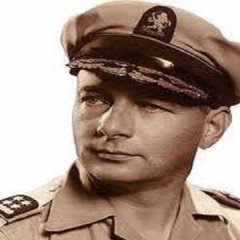-
Content Count
100 -
Joined
-
Last visited
-
Medals
-

[Release] Radio Jamming Script for Task Force Radio
rebel12340 replied to rebel12340's topic in ARMA 3 - MISSION EDITING & SCRIPTING
I believe that both long and short range radios use the same variable to determine their transmission power, so you can't jam a player's short range radio separate from their long range radio. Someone can correct me if I'm wrong. -

[Release] Radio Jamming Script for Task Force Radio
rebel12340 replied to rebel12340's topic in ARMA 3 - MISSION EDITING & SCRIPTING
I've never used Achilles, so I'm afraid I can't really be of much help with that. -

[Release] Radio Jamming Script for Task Force Radio
rebel12340 replied to rebel12340's topic in ARMA 3 - MISSION EDITING & SCRIPTING
yea, that should do it -

[Release] Radio Jamming Script for Task Force Radio
rebel12340 replied to rebel12340's topic in ARMA 3 - MISSION EDITING & SCRIPTING
Add this to line 57 of the script (below where they TF receiving and sending distance multipliers are being set) if (_interference > 1) then {hint "Your radio is being jammed!"}; -

[Release] Radio Jamming Script for Task Force Radio
rebel12340 replied to rebel12340's topic in ARMA 3 - MISSION EDITING & SCRIPTING
Do you want it for testing purposes or to show during the actual mission? -

[Release] Radio Jamming Script for Task Force Radio
rebel12340 replied to rebel12340's topic in ARMA 3 - MISSION EDITING & SCRIPTING
Kromka provded a way of adding an add action on the first page of this thread. https://forums.bohemia.net/forums/topic/203810-release-radio-jamming-script-for-task-force-radio/?do=findComment&comment=3178248 -

[Release] Radio Jamming Script for Task Force Radio
rebel12340 replied to rebel12340's topic in ARMA 3 - MISSION EDITING & SCRIPTING
Double check that the variable name(s) you have in the activation of the script match the variable name you have assigned to the object(s) you want to act as the jammer(s). In other words, if you're executing the script as such: [[jammer1, jammer2, jammer3], 1000, 50, TRUE] execVM "scripts\TFARjamRadios.sqf"; You would need to have three jammers, one named jammer1, one named jammer2, and one named jammer3. Hope that helps. -

[Release] Radio Jamming Script for Task Force Radio
rebel12340 replied to rebel12340's topic in ARMA 3 - MISSION EDITING & SCRIPTING
This could probably be done using the OnTangent event handler for TFAR: https://github.com/michail-nikolaev/task-force-arma-3-radio/wiki/API:-Events As far as I'm aware, the size of the area shouldn't really be a factor as far as performance goes. The only thing I can think of that would affect performance would be the amount of jammers, as the script has to find the distance from the player to each jammer to find the closest one. I haven't done any real sort of testing on the matter to see what sort of performance impact there is, though. -

[Release] Radio Jamming Script for Task Force Radio
rebel12340 replied to rebel12340's topic in ARMA 3 - MISSION EDITING & SCRIPTING
In addition to what Dedmen said, looking at your initPlayerLocal.sqf you have the following lines: Line 1: radioJammer = [[jammer1, jammer2], 1000, 50, TRUE] execVM "scripts\TFARjamRadio.sqf"; Line 2: if (side player == EAST) then {jamOpforRadios = [[Jammer1]] execVM "TFARjamRadios.sqf";}; Line 3: if (side player == WEST) then {jamBluforRadios = [[Jammer2]] execVM "TFARjamRadios.sqf";}; You should really only be using either line 1 by itself or lines 2 and 3 together, not all three lines together. The way you currently have it, the script will run twice (unless the player's side is set to independent), which may cause some issues. -
Spoor started following rebel12340
-

[Release] Radio Jamming Script for Task Force Radio
rebel12340 replied to rebel12340's topic in ARMA 3 - MISSION EDITING & SCRIPTING
You are running the script with debug mode enabled. All you need to do is remove the last parameter in the line used to execute the script (the bit that says TRUE) and the text/markers will stop showing up. It should end up looking similar to this: jamRadios = [[JAMMER],1000,50] execVM "TFARjamRadios.sqf"; -

[Release] Radio Jamming Script for Task Force Radio
rebel12340 replied to rebel12340's topic in ARMA 3 - MISSION EDITING & SCRIPTING
Radio Jamming for TFAR Script update (version 0.2.0) Download Link: Radio Jamming Script for TFAR version 0.2.0 Changelog - The debug function will now create markers locally rather than globally. - The script will now (properly) jam sending transmissions as well as incoming transmissions. - Changed the default "strength" of the jammer to 50 (previously 100) to hopefully compensate for sending transmissions being jammed. Note: Due to some of the changes in this script, if you choose to update any of your missions that used the previous version of this script, and had set a custom strength value for the script, then you may want to lower the custom strength value that you had set. If you experience any issue with the update, please don't hesitate to let me know. -

[Release] Radio Jamming Script for Task Force Radio
rebel12340 replied to rebel12340's topic in ARMA 3 - MISSION EDITING & SCRIPTING
If you open the script, that information is listed at the top. Parameter(s): 0: ARRAY of object(s) (Required)- Entity(s) that will cause the radios to be jammed. 1: NUMBER (Optional)- Range of the jammer in Meters. Default is 1000. 2: NUMBER (Optional)- Strength of the jammer. Default is 100. 3: BOOL (Optional)- Enable Debug. Default is False. Example: [[jammer1],500, 100] execVM "TFARjamRadios.sqf";// This would make jammer1 the active jammer, and would have a radius of 500m and a strength of 100. -

[Release] Radio Jamming Script for Task Force Radio
rebel12340 replied to rebel12340's topic in ARMA 3 - MISSION EDITING & SCRIPTING
Of course! -

[Release] Radio Jamming Script for Task Force Radio
rebel12340 replied to rebel12340's topic in ARMA 3 - MISSION EDITING & SCRIPTING
Since the script runs on each client locally, you would just need to run the script for each side. I believe you would just change the code in the initPlayerLocal.sqf to something similar to this: if (side player == EAST) then {jamOpforRadios = [[Jammer1]] execVM "TFARjamRadios.sqf";}; //Jams Opfor's radios, using Blufor's jammer as the active jammer. if (side player == WEST) then {jamBluforRadios = [[Jammer2]] execVM "TFARjamRadios.sqf";}; //Jam Blufor's radios, using Opfor's jammer as the active jammer. -

[Release] Radio Jamming Script for Task Force Radio
rebel12340 replied to rebel12340's topic in ARMA 3 - MISSION EDITING & SCRIPTING
Having not tested it, something such as this, I think, would get the job done: Action to Enable the jammer jammer1 addaction ["Enable Jammer", {[[[jammer1]],"scripts\TFARjamRadios.sqf"] remoteExec ["execVM"];}] Action to disable the jammer jammer1 addaction ["Disable Jammer", {jammerEnabled = false; publicVariable "jammerEnabled";}]; And then you'd have to edit the script and put this somewhere near the top: jammerEnabled = true and edit the while loop to be dependent on jammerEnabled being true while {alive _jammer AND jammerEnabled} do That could be one way of doing it.




